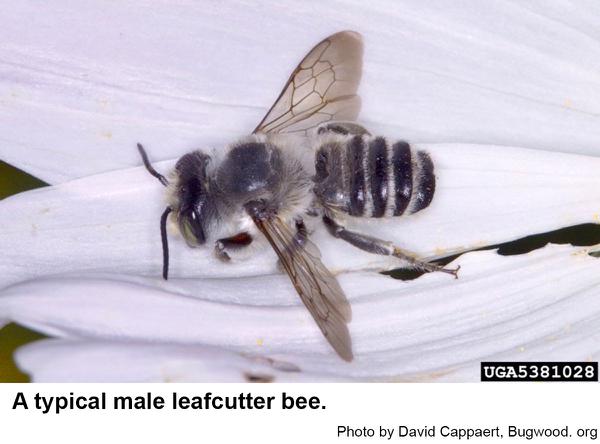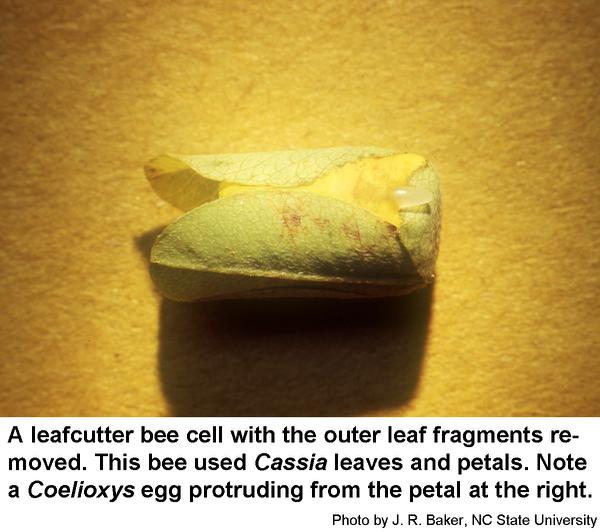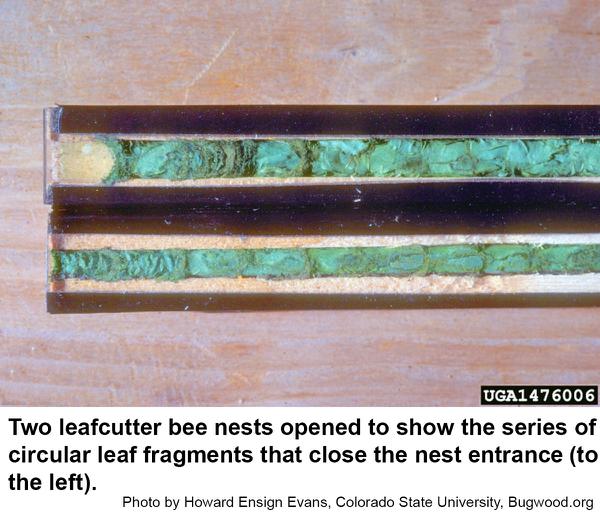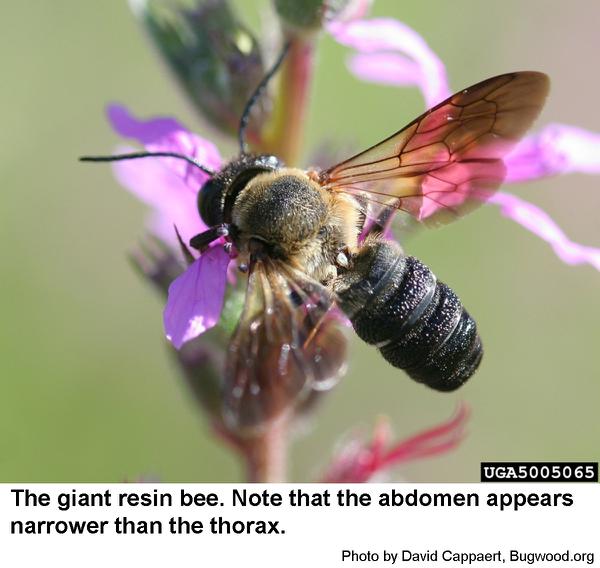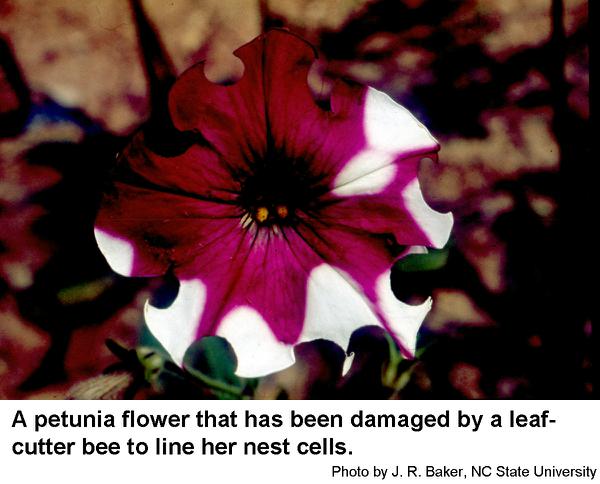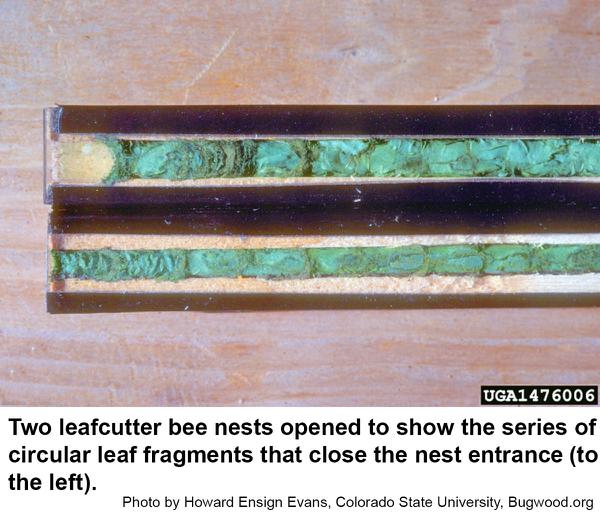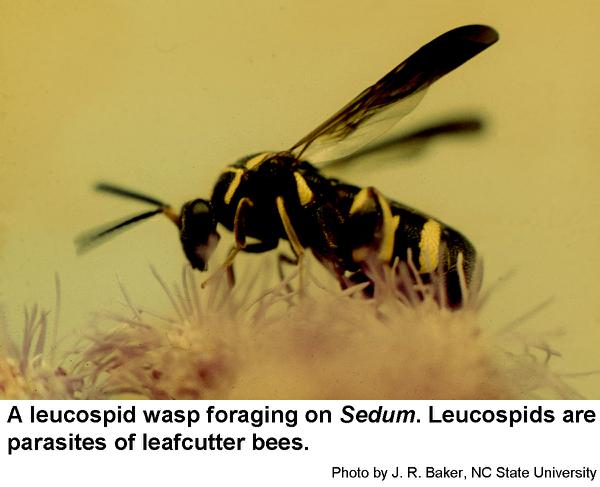Description and Biology
Leafcutter bees, genus Megachile, are solitary insects that construct nests in narrow cavities. Females find a cavity and then construct of a series of cells made of pieces of leaves and petals that they cut with their mandibles. Our leafcutter bees are about the size of a honey bee but are mostly black with contrasting bands of white setae on the abdomen. Females have a conspicuous scopa ("pollen basket") of long hairs on their lower abdomens with which they transport pollen. Female abdomens are somewhat pointed. Males tend to be smaller, with very hairy faces and blunter abdomens (no scopa and no stinger). When a female leafcutter bee finds a suitable cavity she then finds suitable foliage and flowers to cut to construct cells. They cut round pieces for a base and then oval pieces for the walls. Cells are usually built of leaf fragments on the outside and then lined with petal fragments if suitable flowers are in the vicinity. Females then provision the open cell with a mixture of pollen and nectar. An egg is laid on the pollen mass and females then cut additional round pieces of foliage to cap the cell. Each cell is about half an inch long. This process is repeated so that the cavity is eventually filled with eight or nine cells and capped with sometimes numerous, round leaf fragments. Females are able to control the sex of their offspring by withholding sperm from male eggs. Because males develop faster than females they emerge first from the nest so the mother bee lays female eggs in the deepest cells and male eggs closer to the entrance. New leafcutter bees have to chew through the intervening cells to exit the nest, but they wait until their younger siblings have emerged before them. In other words, they do not chew up any siblings that block their exit. Leafcutter bee grubs are legless and pale. They molt as they grow and finally develop into a prepupa that spins a tough, silken cocoon that soon turns dark brown. These grubs then molt into pupae that eventually molt into new adults. The last eggs laid in late summer and early fall hatch into grubs that develop into a prepupal stage that overwinters inside the cocoon. Warming temperatures the next spring induce the prepupae to molt into pupae from which new adults emerge later. We have at least three generations of leafcutter bees each year in North Carolina. Megachile brevis and Megachile mendica are our most abundant species. The alfalfa bee, Megachile rotundata, is a non-native leafcutter bee that has been domesticated and is widely used for the pollination of alfalfa. The giant resin be is another introduced species, Megachile scupturalis. It is remarkable for its large size (up to 1 inch!) and that it does not cut leaves. It was first collected in the United States in 1994 on the campus of NC State University.
Host Plants
Leafcutter bees visit numerous flowers for pollen and nectar. For nest building, they seem to prefer plants with petals and leaves that are not thick or stiff.
Residential Recommendations
Many parasitoids attack the nests of leafcutting bees, including flies, wasps, and beetles. Coelioxys, a genus within the leafcutting bee family, is a group of kleptoparasites (they lay their eggs in the nests of other leafcutter bees and their young kill the leafcutter grub and then eat all of the stored pollen). Acrobat ants have been known to attack leafcutter bee nests. Leafcutter bees are superior pollinators of some difficult-to-pollinate crops such as apples and legumes, especially alfalfa. Leafcutter bees are solitary and have no nest guarding instinct. They rarely sting people other than entomologists who handle them carelessly. No pesticide recommendations are needed.
References
- Common name: leafcutting bees, scientific name: Megachilidae (Insecta: Hymenoptera: Megachilidae: Megachilinae). Serrano, D. 2014 (revised). Featured Creatures, Entomology & Nematology, FDACS/DPI, EDIS. Publication Number: EENY-342.
- First Records of Megachile (Callomegachile) sculpturalis Smith (Hymenoptera:Megachilidae) in the Continental US. Mangum, W. A. and R. W. Brooks. 1997. Jour. Kans. Ent. Soc. 70(2). pp. 140-142.
- Leaf Cutting Bees (Megachile spp.). Moisset, B. No Date.USDA Forest Service.
- Conserving Native Bees on Farmland (E2985). Isaacs, R. 2015. Michigan State University, MSU Extension.
- The North American Invasion of the giant Resin Bee (Hymenoptera: Megachilidae). Hinojosa-Díaz, I. A., et al. 2005. Journal of Hymenoptera Research. 14 (1): 69-77.
- Extension Plant Pathology Publications and Factsheets
- Horticultural Science Publications
For assistance with a specific problem, contact your local N.C. Cooperative Extension Center.
This Factsheet has not been peer reviewed.
Publication date: Oct. 23, 2017
Reviewed/Revised: Aug. 3, 2022
N.C. Cooperative Extension prohibits discrimination and harassment regardless of age, color, disability, family and marital status, gender identity, national origin, political beliefs, race, religion, sex (including pregnancy), sexual orientation and veteran status.


